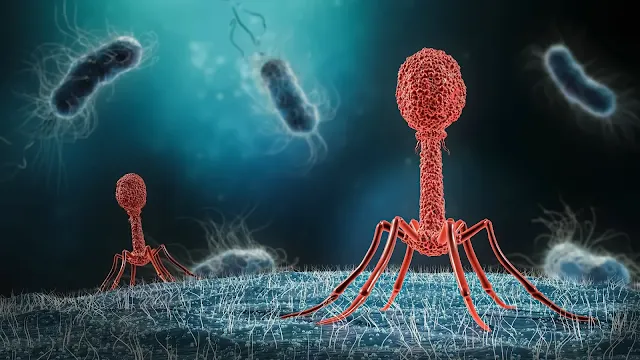Bacteriophages (also known as phages) are viruses that parasitize bacteria i.e. the bacterial cell serves as a host for the virus (hence the name; Bacterial Viruses).
These viruses infect and replicate only in bacterial cells. They are known to be the most abundant biological agent on earth [1].
Morphology of the Bacteriophage
In most cases, the bacteriophage consists of:
- A head: containing the nucleic acid core (usually DNA, rarely RNA) surrounded by a protein coat (capsid).
- A tail: consists of a hollow core surrounded by a contractile sheath which ends in a base plate to which tail fibers are attached.
 |
| Structure of bacteriophage |
Replication (Propagation) of Bacteriophages
Two cycles for phage replication are known:
A. Lytic (vegetative) cycle:
It is so-called because it ends in lysis of the bacterial host cell and release of the newly formed phages.
The stages of this cycle are:
- Adsorption: The phage attaches, by its tail, to specific receptors on the bacterial cell. The specificity of this process determines the susceptibility of bacteria to different phages.
- Penetration: The tail sheath contracts and the nucleic acid is injected into the cell. The empty head and the tail are left outside the cell.
- Eclipse phase: in which no phage components are detected inside the cell. It takes a short time (minutes to hours) during which viral nucleic acid directs the host cell metabolism to synthesize the enzymes and proteins required for phage synthesis.
- Intracellular synthesis: of phage nucleic acids, capsids and tails. Several hundreds of phage components are synthesized.
- Assembly: The phage components aggregate to form complete phage particles which mature into typical infectious phages.
- Release: The bacterial cell bursts liberating a large number of phage particles to infect new cells.
N.B.: During the lytic phage cycle, fragments of the bacterial DNA may be incorporated into the phage head. The phage can then transfer the incorporated bacterial DNA into another bacterial host "generalized transduction".
 |
| Fig. 2: Replication of bacteriophage |
B. Temperate (lysogenic) cycle:
In this cycle, the phage (temperate phage) does not replicate and lyse the bacteria but the phage DNA becomes integrated with the bacterial chromosome and divides with it to pass into daughter cells.
The integrated phage genome is called "prophage" and the bacteria carrying it are called "lysogenic" bacteria.
The presence of the prophage in the bacterium renders it:
- Immune to infection by another phage.
- Lysogenic, i.e. the bacterium acquires new properties, e.g. diphtheria bacilli can produce toxin only when lysogenized.
Acquisition of a new character coded for by a prophage DNA is called "lysogenic conversion", or "phage conversion". When the phage is lost from the bacterium, this new characteristic is lost.
Outcome of the temperate cycle
- The prophage may be carried inside the bacterial cell indefinitely, passing to daughter cells.
- The prophage may be induced to detach from the bacterial chromosome and start a lytic cycle. Induction may be spontaneous or achieved by an inducer, e.g. U.V. light.
During the process of induction, the prophage may carry with it few genes of the bacterial chromosome. When it infects another bacterium, it passes this fragment to it giving it new characters. This is known as "specialized transduction".
Practical Uses of Bacteriophages
- Phages are used as cloning vectors in recombinant DNA technology. They carry and introduce foreign DNA fragments into a host cell.
- Phage typing: Since bacteria differ in their sensitivity to different phages, phages are used to identify and type strains of bacteria that are biochemically and antigenically indistinguishable. This phage typing is important in epidemiologica studies, e.g. to trace the source of infection in outbreaks of post-operative wound sepsis caused by Staphylococcus aureus.
- Phages are used as research elements in some biological and genetic studies.
